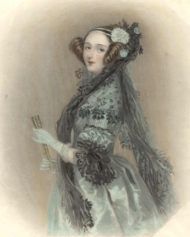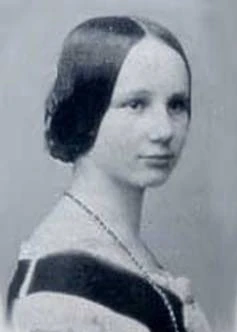
When we think of computers today, we think of a Mac or a PC, a laptop or a desktop. If we go back further, we think of the large computers that were seen in movies. They’re comprised of banks of machinery and wires, spitting out long reams of paper. Regardless of the mental image, it typically consists of icons of the twentieth and twenty-first centuries. However, to consider the history of the computer, we need to go back to the 19th century. Specifically, to Victorian England. We need to look at the life of Ada Lovelace, one of the first computer pioneers. Consider her unique contribution to the way we conduct business and communicate on a daily basis.
Early Life
Augusta Ada Lovelace was born on December 10, 1815. Her parents being the famous poet Lord Byron and his wife, Anne Milbanke. Ada, as she would be called, was named after Byron’s half-sister, Augusta Leigh. Ada was born just eight months after Elizabeth Medora Leigh, Augusta Leigh’s illegitimate daughter. That would have made Ada and Elizabeth cousins. However, it was rumored that Lord Byron was actually the father of Elizabeth. Which would have made them half-sisters. The birth scandal, Lord Byron’s mood swings, and scandalous reputation all led to Annabella leaving her husband. She took their daughter with her, just five weeks after Ada’s birth. Ada never saw her father again. Byron left England just days after, and he died in Greece in 1828 at the age of 37.
Mathematics
Meanwhile, Ada’s mother was hard at work, molding and shaping Ada into the woman she would become. It is said that Annabella did not want Ada to become a poet like her father. She therefore pushed her in alternate directions. Annabella was interested in mathematics, so it is not surprising that she directed her daughter to learn the subject. Mathematics was not seen as a feminine pursuit in the early 19th century, so she was also instructed in music. This was a more appropriate pursuit for a young lady of Ada’s social status.
Even though it interested her, Ada did not show an immediate affinity for math. To ensure that she would excel, Annabella applied what by today’s standards, would be seen as abusive pressure to perform. When Ada expressed a preference for geography over mathematics, her mother forced her tutor to teach one less geography lesson, and one more math lesson. Additional punishments included solitary confinement, being required to lie motionless, and being made to write letters of apology for her academic transgressions.
Confinement
Ada’s entire life was marked by ill health. In 1829, she contracted an illness of unknown origins, which left her unable to walk for the next three years. It is possible that the confinement caused her to concentrate further on her studies. As it was during this period that she became an accomplished musician, mathematician, and linguist. Another woman of unusual accomplishment in the male-dominated society in which they lived was Mary Sommerville. She was a mathematician who published a book called The Mechanism of the Heavens. She and Ada became friends in 1832. Sommerville ended up introducing Ada to two key figures in her life: her future husband, Lord William King, and the man with whom she would collaborate on her most recognized work, Charles Babbage.
Two Different Engines
Ada and William King married in 1835. In 1838 they became Earl and Countess of Lovelace. They had three children together, Byron, Annabella, and Ralph Gordon. The family lived at Ockham Park, at Ockham, Surrey. Through Mrs. Sommerville, Ada met Charles Babbage, who had produced a Difference Engine, which calculated mathematical tables—an early calculator. He had designs to improve upon the idea, resulting in the idea of the Analytical Engine. This invention used loops of punch cards that made decisions based on the results of preceding computations. This took the idea of a calculator to the next level, that of the computer. Ada understood Babbage’s work well because of her extensive mathematical training. The pair developed a close relationship, thus beginning her pioneering work in computers.
When Louis Menebrea published a paper in French on Babbage’s Analytical Engine, Babbage enlisted Ada to translate it. During a nine month period, she translated Menebrea’s paper, and produced a set of notes to go along with it. Her notes were three times the length of the original article. They ended up being published in Richard Taylor’s Scientific Memoirs in 1843. Since social norms dictated against a woman publishing in what was seen as a man’s field, only a select few knew who the actual author of the paper was. It was signed simply with her initials, “A.A.L.”
The Analytical Engine and the Defense Department
Ada began her description with a summary of how the Difference Engine and Analytical Engine differed from one-another. While the Difference Engine required a human programmer to set the initial values to enter data that had been computed and set into columns, the Analytical Engine used punch cards to perform computations and respond to symbols that represented data. Ada wrote that the Analytical Engine could use general information and instructions supplied on the operation cards, and that it could be programmed. Of particular note was her detailed algorithm for the generation of Bernoulli numbers. As a result of this particular part of her notes, she is recognized for writing the first computer program. Ada saw tremendous potential in the Analytical Engine to perform complex mathematical computations without the risk of error. She also foresaw artificial intelligence, and even envisioned the machine as having the potential to create music.
Babbage’s Analytical Engine never made it out of the planning stage. According to some historians, that was in part due to his incessant tinkering. However, the work that he and Ada produced together laid the groundwork for the very technology that we enjoy today. In recognition of Lovelace’s contribution, the computer language created by the U.S. Defense Department was named Ada. On December 10 (Ada’s birthday), 1980, the reference manual for the language was approved, and the Department of Defense Military Standard for the language, “MIL-STD-1815” was numbered after the year of her birth. More recently, Microsoft honored her by incorporating her image into their product authenticity hologram. In 1998, the British Computer Society began awarding a medal in Ada’s name, and in 2008 they started an annual competition for female computer science students.
A Medal
By the time Ada completed her work on the Analytical Engine, she was the subject of great concern among her friends. She took numerous medications for a myriad of health problems. It was not until much later that she was diagnosed with uterine cancer, which caused her extreme pain. At the young age of 37, physicians who were trying to treat her cancer bled her to death. Coincidentally, doctors trying to cure her father Lord Byron of a cold bled him to death at the age of 37. Ada was buried next to her father, whom she had never known, at the Church of St. Mary Magdalene in Hucknall, Nottingham. Her notes on Babbage’s Analytical Engine were re-published in 1953. She will always be remembered for her contributions to the future of computers and technology. She is truly one of the first pioneers in the world of computers.
